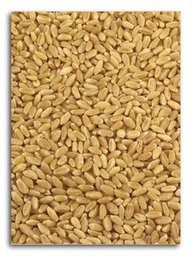
Spring hard white wheat is a high gluten grain, just like the hard red. You can think of it like an albino hard red. There may be someone in your house hold that just doesn't like whole grain, hard white may be a way to get your loved ones eating whole grain and loving it.
The most obvious difference between hard red and hard white is the color of the bran, it's lighter in color making the finished product more like processed flour. Hard white wheat has been developed from hard red wheat, according to Bob's Red Mill.
Hard white has a little less protein compared to hard red, but will be fine for bread, or any yeast product. The significant difference between these two types of wheat is taste. The breeding of white wheat has given it a flavor that differs from its parent wheat. Red wheat tends to be bitter. To compensate, bakers add additional sweeteners to recipes that disguise the taste. White is less bitter in taste than the hard red wheat. Goods produced with hard white wheat require fewer sweetening agents.
Ultimately, the determining factor will be preference. Some people will want the lighter color, milder and sweeter flavor of hard white wheat. Others may desire the firm texture associated with products made from hard red wheat. White whole-wheat also has a finer texture than red whole-wheat flour, so the finished baked goods made with this flour also have a finer texture.
The most obvious difference between hard red and hard white is the color of the bran, it's lighter in color making the finished product more like processed flour. Hard white wheat has been developed from hard red wheat, according to Bob's Red Mill.
Hard white has a little less protein compared to hard red, but will be fine for bread, or any yeast product. The significant difference between these two types of wheat is taste. The breeding of white wheat has given it a flavor that differs from its parent wheat. Red wheat tends to be bitter. To compensate, bakers add additional sweeteners to recipes that disguise the taste. White is less bitter in taste than the hard red wheat. Goods produced with hard white wheat require fewer sweetening agents.
Ultimately, the determining factor will be preference. Some people will want the lighter color, milder and sweeter flavor of hard white wheat. Others may desire the firm texture associated with products made from hard red wheat. White whole-wheat also has a finer texture than red whole-wheat flour, so the finished baked goods made with this flour also have a finer texture.
 RSS Feed
RSS Feed
